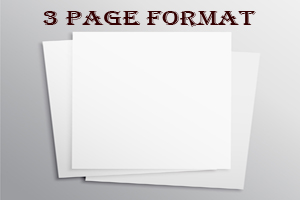
Quality Education based services
Quality education services ensure comprehensive learning, employing innovative methods, skilled educators, and tailored curriculum, fostering holistic development and lifelong success for every learner..
Educational Support
Supporting educational activities.
THREE PAGE FORMAT
Facility to THREE PAGE FORMAT From SAMSA - | Samridh Sathi | Through THREE PAGE FORMAT work is done easily by Samridh Sathi, this is a trusted Institution. You all should get the work done here and you all will be happy to get it done here. Because Samridh Sathi behaves friendly in the institution and also understands him. A page format contains formatting controls for your data set that indicate where and how text, and optionally, page overlays and page segments are to be placed on the page. The page format is defined relative to the origin of the sheet specified in the form definition. A page format can specify one of three types of data: Traditional line data, which might contain CCs and TRCs Record format line data, which contains record IDs and might contain CCs XML data All page formats in the page definition must specify the same type of data. If you do not specify a type of data, the page format assumes you are using traditional line data. For information about using types of line data, see Line data or see Advanced Function Presentation: Programming Guide and Line Data Reference, S544-3884. For information about using XML data, see XML data. A page format can contain the following information: Size of the page area to be formatted, specified as the width and height of the page (required) Print direction Relative print line positioning Options for already formatted print records Formatting options for individual fields in print records Fonts Conditional processing Page size The page size, width, and height are defined in the page format. This area is called the logical page. All the text and images contained in your print data set must fit within the boundaries of this logical page. The logical page should cover the entire area of the physical form on which your data can print. If you are printing multiple-up applications (in which two or more pages of application data are formatted on the same side of a physical form), you must make your logical page large enough to contain all the pages of application data (this applies only to multiple-up formatting for which a page definition is used; it does not apply to N_UP printing). Characters or images that extend outside the boundaries of the logical page cannot be printed. Whether you receive error messages indicating the characters or images were not printed depends on the value in the DATACK parameter. For more information, see DATACK. Be careful when positioning text near the top or bottom of the logical page area. The position you specify for character data in your page definition is the position at which the baseline of the characters are printed.10 When you position character data in a page definition, be sure to leave room for the characters and their ascenders and descenders. For example, never place a character 0 inches down from the top of the page. Also be careful not to extend data off the right side of the page, which can happen if your print lines are too long, or if you used a font that is too large to fit within your page area. In most cases you do not need to be concerned with placing characters too near the left margin of the page. Characters are positioned from the front or leading edge of their baseline, so that a character can be placed at the exact left edge of the logical page. Italic fonts, however, can extend off the left edge of the page because they are kerned to tuck under the adjacent characters. Some italic characters extend a few pels to the left of their character space origin. Therefore, when you print with an italic font, be sure to position the text line a few pels to the right of the left edge of the logical page. Print direction The page format assigns a print direction to the lines of text in the logical page. The print direction can be one of four inline directions supported by AFP printers: ACROSS—oriented 0° from the page origin DOWN—oriented 90° from the page origin BACK—oriented 180° from the page origin UP—oriented 270° from the page origin In addition to print direction, AFP text can be printed in four character rotations: 0°, 90°, 180°, and 270°. Each of these character rotations is specified relative to the print direction. Unless you specify otherwise, a 0° rotation is used with any print direction you select for your page definition. For more information about print direction and character rotation, see Printing AFP data in different directions and character rotations..